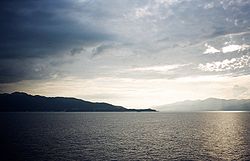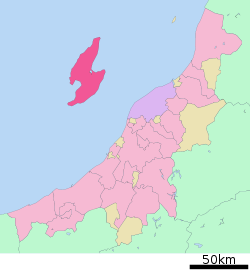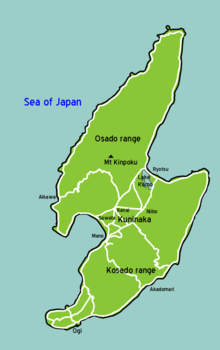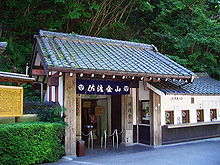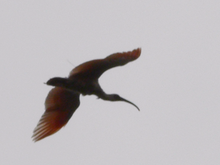- Sado, Niigata
-
Sado
佐渡市— City — Sado from the sea 
FlagLocation of Sado in Niigata Coordinates: 38°1′N 138°22′E / 38.017°N 138.367°ECoordinates: 38°1′N 138°22′E / 38.017°N 138.367°E Country Japan Region Chūbu, Hokuriku Prefecture Niigata Government – Mayor Koichiro Takano (since April 2004) Area – Total 855.26 km2 (330.2 sq mi) Population (April 1, 2011) – Total 63,231 – Density 73.93/km2 (191.5/sq mi) Time zone Japan Standard Time (UTC+9) City symbols - Tree Thujopsis - Flower Daylily - Bird Crested Ibis - Fish Yellowtail Phone number 0259-63-3111 Address 232 Chigusa, Sado-shi, Niigata-ken
952-1292Website City of Sado Sado (佐渡市 Sado-shi) is a city located on Sado Island (佐渡島 or 佐渡ヶ島, both Sadogashima) in Niigata Prefecture, in the Chūbu region of Japan. Since 2004, the city has comprised the entire island, although not all of its total area of 855.26 km2 is urbanized. Sado is the sixth largest island of Japan in area following the four main islands and Okinawa Island (excluding the Northern territories).
Contents
Geography
The island consists of two parallel mountain ranges running roughly southwest–northeast, enclosing a central plain. The Ōsado (大佐渡) range, in the north, is slightly higher, with peaks of Mount Kinpoku (金北山), the highest point of the island at 1,172 m, Mount Myōken, and Mount Donden. Kosado (小佐渡) range in the South faces the Honshu coast. The highest point in Kosado is Ōjiyama (大地山) at 645 m.
The plain in between is called Kuninaka (国中) and is the most populated area. The Kuninaka plain opens on its eastern side onto Ryōtsu Bay (両津湾), and on its western side onto Mano Bay (真野湾), where the longest river, Kokufugawa (国府川, also read Konogawa) reaches the sea.
The island has a global symmetrical shape. Lake Kamo (加茂湖), on the eastern side of Kuninaka, is filled with salt water, and is a growing place for oysters.
Earthquakes
- Kyōwa 2 (December 9, 1802): Earthquake in northwest Honshu and Sado Island (Latitude: 37.700/Longitude: 138.300), 6.6 magnitude on the Richter Scale.[1]...Click link for NOAA/Japan: Significant Earthquake Database
- Kyōwa 2 (December 28, 1802): Earthquake on Sado Island (Latitude: 38.000/Longitude: 138.000).[1]
History
Political formation of the island
The large number of pottery artifacts found near Ogi in the South of the island demonstrate that Sado was populated as early as the Jomon period.
The Nihon Shoki mentions that Mishihase people visited the island in 544 (although it is unknown whether Tungusic people effectively came).
The island formed a distinct province, the Sado Province, separate from the Echigo province on Honshū, at the beginning of the 8th century. At first, the province was a single gun (district), but was later divided into three gun: Sawata, Hamochi and Kamo.
In 1185, the designated representative Shugo for Sado, Osaragi, appointed Honma Yoshihisa as his shugodai (delegate) for the province.
The rule of the Honma clan on Sado lasted until Uesugi Kagekatsu took control of the island in 1589. After the defeat of the Uesugi at Sekigahara, and the discovery of gold on the island, the shogunate took direct control of the island.
The island was for a short time an independent prefecture, called the Aikawa prefecture, between 1871 and 1876, during the Meiji era. It then became a part of Niigata Prefecture, which it is still as of today.
At the end of the 19th century, there were three districts (郡), seven towns (町), and 51 villages (村). During the 20th century, a series of mergers steadily reduced the number of political local authorities, following the recent trend in Japan to cut the costs of having separately run local administrations. The current city (市) covering the whole island was established on March 1, 2004 in a merger of all remaining municipalities on the island: the city of Ryōtsu: the towns of Aikawa, Kanai, Sawata, Hatano, Mano, Hamochi and Ogi; and the villages of Niibo, and Akadomari.
Exile in Sado
When direct control from mainland Japan started around the 8th century, the island's remoteness meant that it soon became a place of banishment for difficult or inconvenient Japanese figures. Exile to remote locations such as Sado was a very serious punishment, second only to the death penalty, and people were not expected to return.
The earliest known dissident to be condemned to exile on Sadogashima was a poet, Hozumi no Asomi Oyu (穂積朝臣老)). He was sent to the island in 722, reportedly for having criticized the Emperor.
The former Emperor Juntoku was sent to Sado after his role in the Jōkyū War of 1221. The disgraced Emperor survived twenty years on the island before his death; and because he was sent to Sado, this emperor is known posthumously as Sado-no-in (佐渡院). He is buried in the Mano Goryo mausoleum on the west coast.[2]
The Buddhist monk Nichiren Daishonin was sent to Sado for three years before his 1274 pardon.
The Noh dramatist Zeami Motokiyo was exiled on unspecified charges in 1434.
The last banishment in Sado took place in 1700, almost a millennium after the first.
Gold mine
Sado experienced a sudden economic boom during the Edo era when gold was found in 1601 at Aikawa (相川). A major source of revenue for the Tokugawa shogunate, the mines were worked in very severe conditions.
Manpower shortage led to a second wave of "exiles" coming to Sado, although this time it was not imposed as a sentence for a committed crime. By sending homeless people (the number of whom was growing in Japanese cities at the time) to Sado from the 18th century, the Shogunate hoped to solve two problems with one move. The homeless were sent as water collectors and worked in extremely hard conditions, with a short life expectancy. The mine at its peak in the Edo era produced around 400 kg of gold a year (as well as some silver). The small settlement of Aikawa quickly reached a population of around 100,000. The mine closed in 1989.
External influence on Sado culture
In feudal Japan, when the Nishimawari naval route was opened in 1672, Ogi (in the South of the Island) became a main stop on this major naval route in the Sea of Japan between the Kansai area and northern areas of the archipelago.
Exiles and shipping in old times both had a major influence on Sado's cultural background. The island is for instance dotted with Noh theaters, and the local Japanese dialect and accent are different from those of Niigata.
Today
Economy
As of April 1, 2011, the island has an estimated population of 63,231 citizens. The island of Sado has seen a steady decline in population since 1950 when the population was 125,597. Similar trends have been common in other remote locations of Japan since World War II as younger generations have moved to more urban areas. As of October 1, 2008, 36.3% of the island population is over 65 years old, which is a larger ratio than the national average. Over 65 is the only increasing age demographic. The island is now less populated than it was in the 18th and 19th century. There is no university, and the options for post high school studies, short of leaving and going to the mainland, are very limited.
Transportation links from and to mainland Japan are under tremendous economic pressure. Kyokushin Airways, operating the airline to Niigata, ceased its operations in September 2008. Currently, New Japan Aviation operates 3-4 flights per day to Sado Airport. The closing of secondary maritime liaisons is also under discussion.[clarification needed]
Agriculture and fishing are major sources of income for Sado. According to the 2000 national census, 22.3% of the working force was working in the primary sector and 25% in the secondary sector. Fishing is mainly based in Ryotsu and Aikawa.
Tourism boomed in the beginning of the 1990s with peaks over 1.2 million yearly visitors, but visitor number decreased over the 90s. In the mid 2000s, the number of visitors is closer to 650,000 per year.
Tourism
Its rich history and relaxed rural atmosphere make Sado one of the major tourist destinations in Niigata Prefecture. The island has several temples and historical ruins, and offers possibilities for various outdoor activities, as well as fresh local food.
Sado is famous as the major breeding area for the Japanese Crested Ibis. The last known Japan-born Japanese Crested Ibis died in captivity in 2003 on the island. Currently, birds from China are being bred in a captive program in a facility in Niibo area. The Ibis, Toki in Japanese, is a major symbol of the Island and can be found on several tourist items. There are plans to release Ibis in the wild at the end of 2008.
There are many small local traditional festivals, and since 1988 a major yearly arts festival, called the Earth Celebration, has been run by the taiko group Kodō. The group lives on the island, touring 8 months a year, and in August they invite international artists to collaborate with them at their festival on Sado. Tickets are limited for the three-day weekend event. In recent years, Kodō has made a solo performance on the Friday evening; the festival's invited act plays Saturday night; and Sunday concludes with a joint performance with Kodō and guests.
The Sado tourism industry suffered direct (though limited) as well as indirect damage from the 2004 Chūetsu earthquake, as access routes inside Niigata prefecture were cut.
References
- Bornoff, Nicholas (2005). National Geographic Traveler Japan. 2nd ed. Washington, D.C.: National Geographic Society. ISBN 079223894X. OCLC 60860593.
External links
- Sado Tourism Association English language site
- Sado City (in Japanese)
- Sado Island's English language site
- Sado Island as host to "Earth Celebration"
- Sado Island travel guide from Wikitravel
- Map of Sado Island
 Niigata Prefecture
Niigata PrefectureNiigata (capital city) 
Cities Districts Categories:- Cities in Niigata Prefecture
- Islands of Japan
- Islands of the Sea of Japan
- Port settlements in Japan
- Populated coastal places in Japan
Wikimedia Foundation. 2010.

